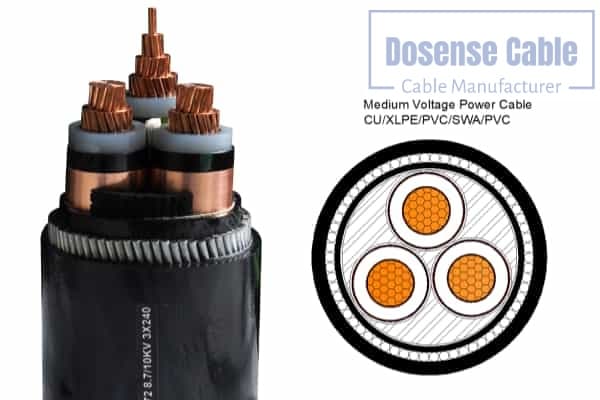Medium voltage cable
A medium voltage cable designed to carry electricity at voltages ranging from 3 kV (3000 volts) until 35 kV (35 000 volts).
Medium voltage cables are commonly used in electrical power distribution in urban and suburban areas., as well as in industrial and commercial applications.
Medium voltage cable depending on factors such as specific application, electric charge, environmental conditions and safety requirements. Medium voltage conductor cables, copper and aluminum cables, cross-linked polyethylene insulation (XLPE), steel wire armor, PVC cover.
Medium Voltage Cable
XLPE insulated medium voltage cable
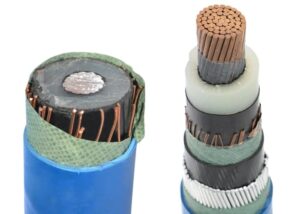
1.Conductor: Compact Round Copper and Aluminum
2. semiconducting layer: a semiconductor layer of conductor can be applied, insulation and screen to ensure a uniform electric field and reduce the possibility of partial discharge.
3. Isolation: XLPE insulation or EPR insulation.
The insulation materials for medium voltage cables are cross-linked polyethylene. (XLPE), ethylene-propylene (EPR) suitable to withstand the highest stresses.
4.Screen system: copper wire and copper tape.
Medium voltage cables will include shielding systems to control electric fields and reduce dielectric stress.
5.Outer sling: PVC, MDPE,
Outer sheath provides mechanical protection and moisture protection, abrasion and other environmental factors.
Cable URD (Underground Residential Distribution) of 35kV
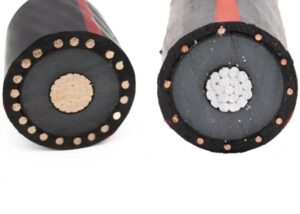
Cable URD (Underground Residential Distribution) of 35 kV is a power cable designed for underground distribution. The voltage is 35 kilovolts (35 kV) or less and should not exceed 90 °C in normal use temperature.
These cables are used in urban and suburban areas to transport electricity from distribution substations to residential and commercial areas..
Conductor: Copper and aluminum.
Isolation: XLPE.
The conductor is insulated with materials such as cross-linked polyethylene (XLPE) or ethylene propylene rubber (EPR), capable of withstanding temperatures up to 90°C without degradation.
Armor: copper wire screen.
Deck: PVC or MDPE. An outer jacket made from materials such as polyvinyl chloride (PVC) or high density polyethylene (HDPE) provides mechanical protection and greater insulation from environmental factors.
1/C,3/C WITH 15KV 220 NL-EPR 133% TS ARMOR-X PVC MV-105 Cable
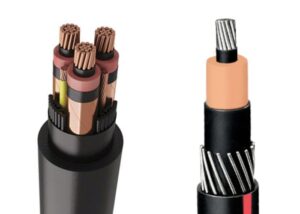
“Cable 1/C, 3/C WITH 15KV 220 NL-EPR 133% TS ARMOR-X PVC MV-105” describes a medium voltage power cable with one or three copper conductors, a nominal voltage of 15 kilovolts, lead-free ethylene propylene rubber insulation with a 133% standard thickness, an ARMOR-X type armor and a polyvinyl chloride outer jacket suitable for use in wet or dry locations with a maximum operating temperature of 105°C.
1/C, 3/C: Indicates the number of conductors in the cable. “1/C” refers to a single conductor cable, while “3/C” refers to a three conductor cable.
CU: Means copper, which indicates that the conductive material is copper.
15kV: Indicates the nominal voltage of the cable, that is of 15 kilovolts. The cable is designed to withstand voltages up to 15 kV.
220 NL-EPR: This probably refers to the insulating material used for the cable. “NL-EPR” means lead-free ethylene propylene rubber, which is a type of synthetic rubber commonly used for insulation in medium voltage cables.
133% TS: Could refer to the thickness of the insulation. “TS” means “Total thickness”, which indicates that the insulation is the 133% standard thickness.
ARMOR-X: Refers to the cable armor. Armor is a protective layer typically made of metal wires or tapes that provides mechanical protection to the cable..
PVC MV-105: Indicates the outer sheath material and cable type. “PVC” means polyvinyl chloride, which is a common material used for the outer jackets of power cables. “MV-105” refers to the type of medium voltage power cable suitable for use in wet or dry locations, with a maximum operating temperature of 105°C.
RHV and RHZ1 Cable Specifications
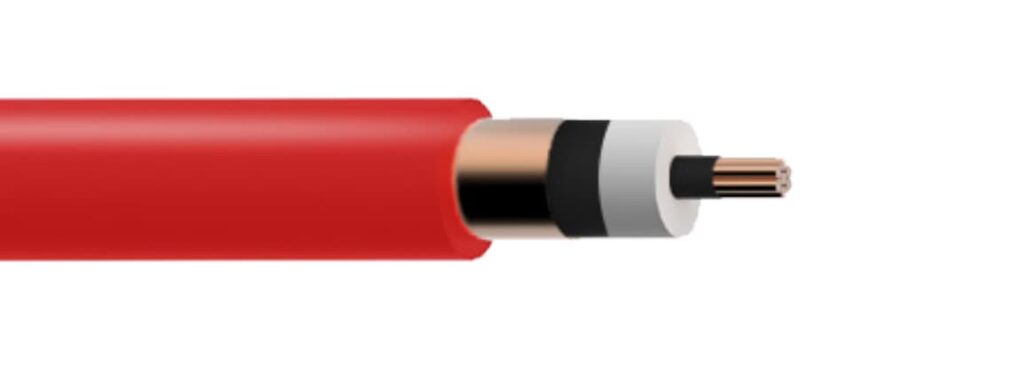
Normative compliance: Manufactured according to Spanish national standard UNE 21-161-93.
Application: Primarily used in primary airfield lighting applications.
Cable types:
Cable RHV: Copper cable with PVC outer sheath.
Cable RHZ1: Copper cable with Halogen-free Polyolefin outer layer.
Isolation: XLPE insulated for a maximum conductor operating temperature of +90°C, suitable for operation in conditions down to -20°C.
Installation: Can be used in static or dynamic installations; The radius of curvature varies accordingly.
Available voltages:
It is most commonly required at a nominal voltage of 6/10 kV for airfield lighting applications.
Other voltages available upon request, included 8,7/15 kV, 12/20 kV y 18/30 kV.
Compliance: complies with Euro CPR Classification and meets regulatory requirements for installation environments.
Quality guarantee: All medium voltage cables (MT) undergo rigorous quality control testing in a dedicated MT laboratory under conditions required by ISO/IEC 17025.
Applications of medium voltage cables
Medium voltage cables are used in a variety of applications where safe and reliable transmission is required..
Energy Distribution: Medium voltage cables are used to transport electrical energy from distribution substations to residential areas, commercial and industrial.
Supply to Industrial Facilities: They are used to supply large industrial facilities such as factories, manufacturing plants, refineries and processing centers.
Public infrastructure power: are used to power important public infrastructures, like hospitals, schools, airports, train stations and public transportation systems.
Street lighting: In some areas, medium voltage cables are used to power public lighting systems, as streetlights and luminaires in parks, avenues and streets.
Mining Applications: In the mining industry, Medium voltage cables are essential for powering equipment and machinery in underground and open pit operations..
Renewable energy: In renewable energy projects, such as wind farms and solar plants, Medium voltage cables are used to connect the generators to the electrical grid.
Substation Connection: Medium voltage cables are used to connect substations to each other, forming an interconnected electrical distribution network.
Backbone of the electrical network: in some applications, medium voltage cables act as the backbone of the electrical network, transporting large volumes of energy efficiently and reliably.
How to design and select medium voltage cables?
The design and selection of medium voltage cables (MT) involves considering several factors to ensure they meet the specific requirements of the intended application while maintaining security, reliability and efficiency. Below is a general guide on how to design and select medium voltage cables:
Determine voltage and current requirements: Identify the voltage and current ratings required for the application. This will determine the proper voltage class and conductor size of the cable..
Understand environmental conditions: consider the environmental conditions where the cable will be installed, including temperature, humidity, chemical exposure and physical stressors.
Select conductor material: decide whether aluminum or copper conductors are best suited for the application. Consider factors such as conductivity, the cost, weight and mechanical properties.
Choose insulation material: Select the appropriate insulation material according to the rated voltage, temperature and environmental considerations. Common insulating materials for medium voltage cables include XLPE (cross-linked polyethylene), EPR (ethylene propylene rubber) y TRXLPE (tree retardant cross-linked polyethylene).
Consider cable construction: determine cable configuration based on installation requirements, as single core or multi core, armored or not armored and armored or not armored.
Assess regulatory compliance: Make sure the selected cable meets the standards, relevant industry regulations and certifications. This may include standards such as IEC, IEEE, NEC or local regulations.
Introduction of medium voltage cable accessories.
Accessories for medium voltage cables (MT) are essential components used in medium voltage power distribution systems to ensure safe and efficient operation.
Terminations: MV cable terminations are used to connect medium voltage cables to electrical equipment such as transformers, switchgear and distribution panels.
Unions/Splices: Medium voltage cable joints, also known as splices, They are used to connect two or more medium voltage cables together.
Cable gland: Cable glands are used to securely connect medium voltage cables to electrical equipment or cabinets.
Cable Clamps: Clamps are used to support and secure medium voltage cables, avoiding excessive movements and ensuring that they maintain their position in installations subject to vibrations or mechanical stress.
Insulation and sealing materials: Various insulation and sealing materials, like ribbons, resins and heat shrink tubes.
Indicators and Voltage Detection Systems: Devices such as voltage detectors and indicators are used to verify the presence or absence of voltage in medium voltage cables and equipment..
Grounding and Grounding Accessories: clamps, Grounding connectors and conductors are used to establish proper grounding and bonding of medium voltage cable systems.
Cable installation and removal equipment: Tools and equipment such as cable rollers are used during the installation of medium voltage cables., traction jaws, lubricants and tensioners.
Test and diagnostic equipment: Various testing and diagnostic devices are used to evaluate the condition, the performance and integrity of medium voltage cables and accessories.

